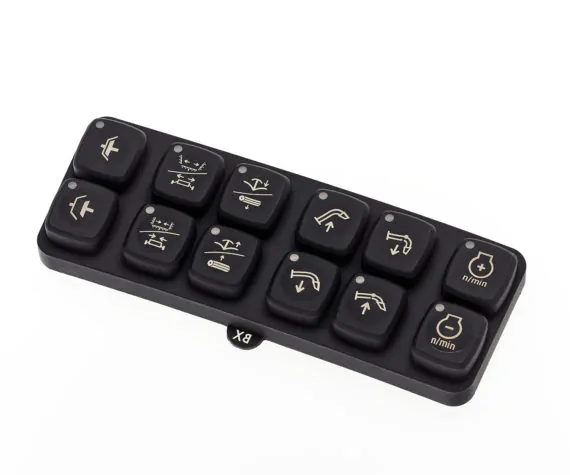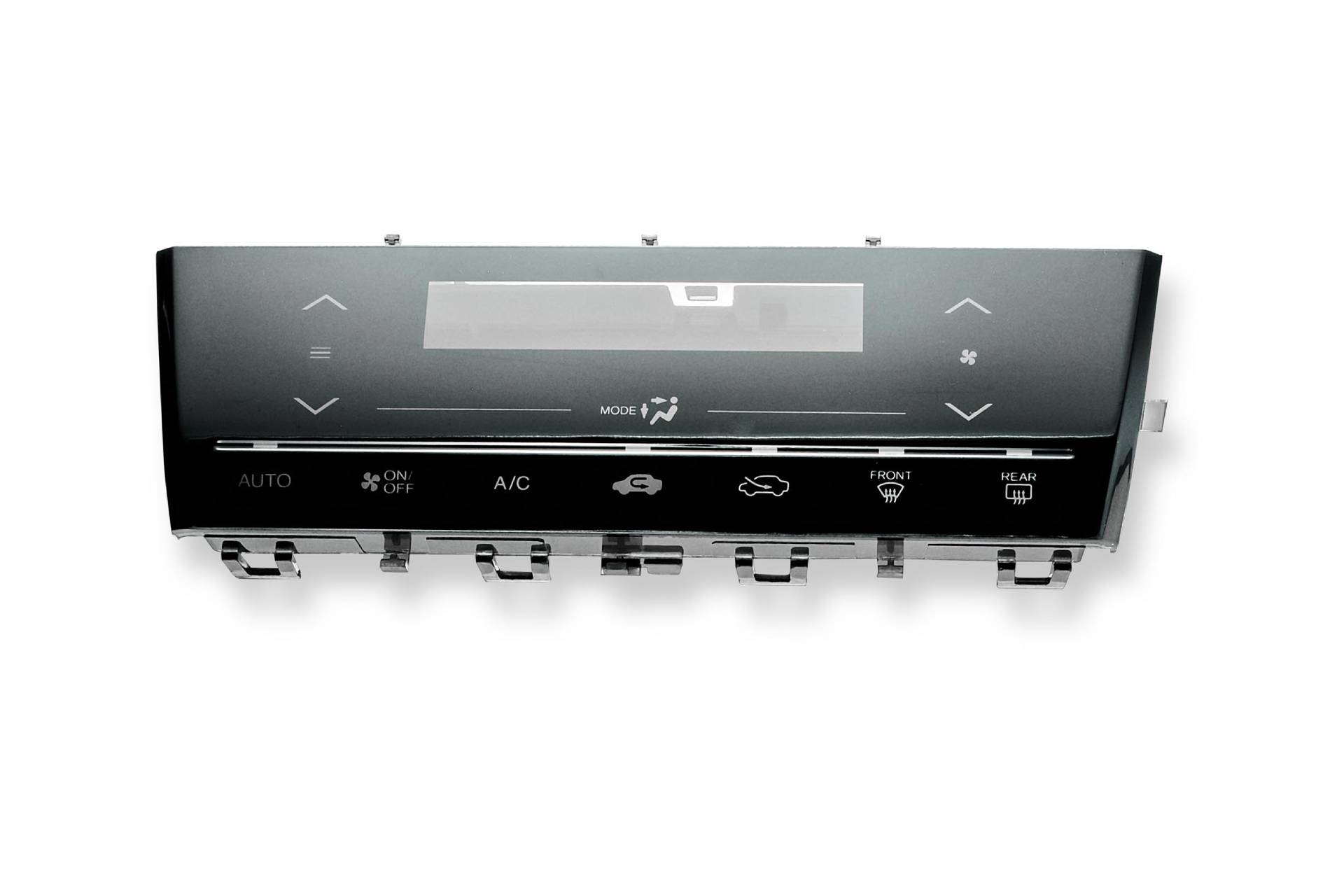Uncovering the Diverse Types and utilizes of Rubber Keypads in the Technology Landscape Today
Rubber keypads have established themselves as essential parts in various technological applications. Their adaptability makes them appropriate for customer electronics, commercial makers, and clinical gadgets. As these keypads proceed to advance, new modification options and design fads emerge. This prompts a closer exam of their benefits and producing processes. Recognizing these components may disclose why rubber keypads continue to be a recommended selection in the technology landscape. What exists ahead for this functional element?
Review of Rubber Keypads
Rubber keypads function as an essential part in numerous digital devices, supplying a responsive user interface for customer communication. These keypads are usually made from silicone or rubber materials, which provide versatility and resilience. Their design commonly incorporates elevated icons or letters, improving usability by allowing users to feel the tricks - Rubber Keypads. Rubber keypads are immune to dust, moisture, and use, making them suitable for requiring settings
Additionally, they can be customized relating to color, size, and shape, permitting suppliers to develop special user interfaces tailored to details items. The manufacturing process commonly includes methods such as molding and printing, making certain premium outcome. Consequently, rubber keypads not just boost functionality but also add to the general aesthetics of the tool. With these features, rubber keypads remain a preferred selection for both consumers and suppliers, highlighting their significance in the technology landscape.
Common Applications in Customer Electronics
While many electronic tools depend on touchscreens for customer communication, rubber keypads continue to play an essential role in customer electronics. These keypads are commonly used in devices such as remotes, pc gaming controllers, and house home appliances, where tactile feedback boosts individual experience. Their toughness and resistance to use make them perfect for tools regularly based on hefty usage.
Rubber keypads are also prominent in smart phones and mobile gadgets, where portable designs require reputable and receptive input methods. The capacity to personalize the form and appearance of rubber keypads allows producers to produce one-of-a-kind designs that attract consumers. Furthermore, the soft touch of rubber gives comfort throughout long term use, making these keypads a preferred selection for devices requiring prolonged communication. In general, rubber keypads continue to be an essential part in the consumer electronic devices landscape, combining capability with straightforward features.
Role in Industrial and Medical Devices
Rubber keypads play a vital role in both clinical and commercial equipment, using resilience and dependability popular atmospheres. In industrial settings, they are typically utilized in control panels and machinery, improving driver communication with complex systems. In a similar way, in the clinical area, rubber keypads promote easy to use user interfaces for tools that need accuracy and health.
Industrial Equipment Applications
Keypads play a necessary role in the performance and individual experience of medical and commercial tools. In industrial settings, rubber keypads offer a durable user interface for machinery and control systems, enabling drivers to easily input commands and adjust setups. Their resistance to dust, moisture, and chemicals warranties integrity under rough problems normal of manufacturing facilities and manufacturing plants. In addition, the tactile comments offered by rubber keypads improves user communication, decreasing the likelihood of input mistakes. In addition to typical machinery, these keypads are integral in automated systems and robotics, where precision is vital. The flexibility of rubber keypads in different commercial applications underscores their value in improving operational efficiency and guaranteeing safety in intricate environments.
Medical Gadget Integration
As medical gadgets progressively require user-friendly user interfaces, the combination of rubber keypads has actually become essential in guaranteeing efficient interaction in between healthcare specialists and devices. These keypads give responsive responses, assisting in instinctive procedure even in high-pressure atmospheres. Their sturdiness and resistance to severe cleaning representatives make them excellent for clinical setups, where hygiene and longevity are vital. In addition, rubber keypads can be customized to consist of different shapes, sizes, and shades, improving aesthetic recognition and ease of access for customers. This versatility enables the creation of specialized controls customized to particular medical functions, enhancing total effectiveness. As a result, the duty of rubber keypads in clinical gadget assimilation not only boosts functionality however likewise advertises individual security and operational dependability in medical care atmospheres.
Modification Options and Design Trends
Recent style patterns stress minimalism and comfort designs, prioritizing individual convenience and instinctive communication. Personalized logo designs and branding can be integrated right into keypads, permitting companies to preserve a natural brand identity across their products. Furthermore, advancements in making techniques, such as silicone molding, have made it easier to achieve intricate layouts and customized designs.
Advantages of Rubber Keypads Over Various Other Kinds
Rubber keypads are likewise recognized for their longevity and resistance to environmental aspects. They can withstand dust, wetness, and temperature level fluctuations, making them ideal for commercial or outside setups. Additionally, rubber keypads are usually quieter than their plastic or metal equivalents, reducing sound pollution in common atmospheres.
The cost-effectiveness of rubber keypads makes them an eye-catching option for producers. Their light-weight nature adds to decrease delivery expenses, while their customizable styles deal with certain branding needs. Generally, rubber keypads represent a flexible and reliable solution in the modern technology landscape.
Production Techniques for High Quality and Toughness
In the manufacturing of rubber keypads, the selection of appropriate materials and molding processes plays an important function in identifying total top quality and durability. Numerous molding techniques, such as compression and shot molding, significantly affect the end product's performance. Understanding these aspects is important for attaining optimal outcomes in rubber keypad production.
Molding Procedures Explained
A variety of molding processes play a vital function in the production of rubber keypads, ensuring both high quality and longevity. The most common methods consist of compression molding, transfer molding, and injection molding. Compression molding includes putting rubber in a warmed mold, where heat and stress shape it right into the desired type. Transfer molding permits even more accurate control over material circulation and is suitable for intricate styles (Rubber Keypads). Shot molding, known for its rate and efficiency, injects liquified rubber right into a mold under high pressure, generating high-volume get rid of consistent quality. Each method supplies unique benefits, influencing factors such as production cost, design, and speed adaptability, eventually affecting the efficiency and life-span of rubber keypads in different applications
Material Selection Significance
Material choice plays a vital duty find more info in the production of rubber keypads, straight affecting their efficiency and resilience. The option of rubber compounds, such as silicone or polyurethane, influences responsive feedback, resistance to wear, and ecological sturdiness. High-grade materials guarantee that keypads can endure substantial use, maintaining their functionality in time. Additionally, the formula of rubber affects its resistance to temperature level variations and exposure to chemicals, which are important for gadgets in various settings. Employing innovative production strategies, such as compression or injection molding, additional enhances the architectural integrity of keypads. Eventually, careful material selection and manufacturing processes add greatly to the total quality, longevity, and customer contentment of rubber keypads in today's innovation landscape.
Future Fads in Rubber Keypad Technology
As modern technology proceeds to develop, the future of rubber keypad technology shows up encouraging, with developments positioned to enhance performance and individual experience. One noteworthy fad is the combination of touch-sensitive modern technology, making it possible for capacitive feedback that resembles the feel of conventional switches while providing improved responsiveness. Additionally, the development of antimicrobial materials is likely to obtain grip, addressing hygiene concerns in shared and public devices.
Moreover, personalization alternatives are anticipated to increase, allowing individuals to customize vital formats and responsive feedback, thereby satisfying diverse demands. The consolidation of wise modern technology, such as connection features, may also arise, enabling rubber keypads to interact with various other tools flawlessly. As suppliers concentrate on sustainability, environmentally friendly materials are prepared for to end up being extra common, lining up with global ecological goals. In general, these patterns promise to revolutionize rubber keypads, making them more functional, straightforward, and environmentally aware in the innovation landscape.
Often Asked Questions
Just How Do Rubber Keypads Compare in Cost to Other Keypad Kinds?
Rubber like this keypads typically use a cost-efficient option compared to other keypad types, such as membrane layer or mechanical options. Their reduced manufacturing expenses and sturdiness make them an appealing choice for numerous applications in innovation.
What Are the Ecological Effects of Rubber Keypad Production?


The ecological impacts of rubber keypad production include source depletion, energy usage, and air pollution from producing processes. Additionally, incorrect disposal can bring about plastic waste, adding to ecological deterioration and hurting ecological communities otherwise taken care of sensibly.
Can Rubber Keypads Be Made Use Of Outdoors?
Rubber keypads can be used outdoors as a result of their durability and resistance to weather elements. Their long life may depend on the high quality of materials utilized and the details environmental conditions they are revealed to.
What Upkeep Is Needed for Rubber Keypads?
Rubber keypads need regular cleansing to remove dirt and debris, routine evaluation for deterioration, and security from severe temperatures. Ensuring proper storage space conditions can prolong their lifespan and maintain performance with time.
Just How Do Rubber Keypads Perform in Extreme Temperatures?
Rubber keypads typically keep capability in extreme temperatures, showing resilience to both cold and heat. However, long term direct exposure may trigger important site product degradation, influencing their tactile feedback and total performance in extreme atmospheres.
Rubber keypads offer as an essential part in various digital gadgets, offering a responsive user interface for individual communication. While numerous digital devices rely on touchscreens for user communication, rubber keypads proceed to play an important role in customer electronics. Furthermore, the soft touch of rubber offers comfort throughout extended usage, making these keypads a favored selection for tools requiring extended communication. Despite the expanding range of keypad products available, rubber keypads offer distinctive advantages that make them a preferred selection in several applications. Rubber keypads usually provide an affordable service compared to other keypad types, such as membrane or mechanical options.